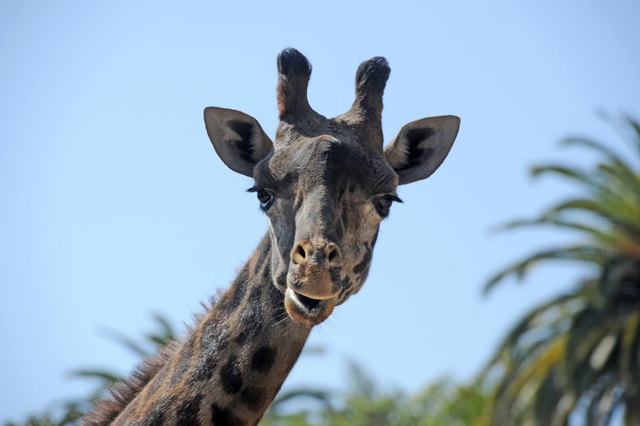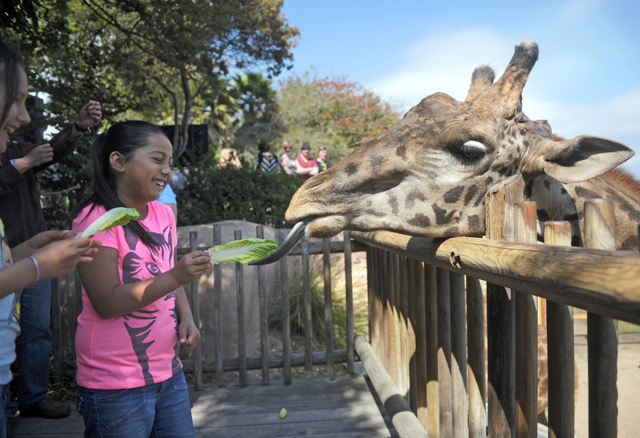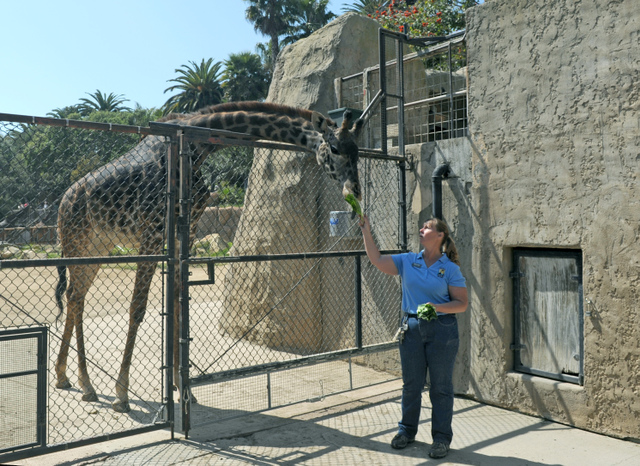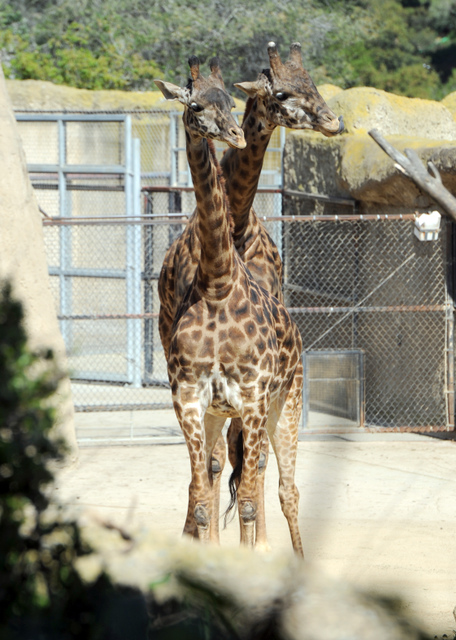Giraffe Births: A Tall Order
Santa Barbara Zoo Gears Up for Two New Additions to Masai Herd

The barn and yard are baby-proofed, the formula is ready, and two expecting mothers are calm but heavy in the last days of their 15-month pregnancies. Any time now — and if all goes to plan — Audrey and Betty-Lou will deliver two giraffe calves around six feet tall and 120 pounds who will walk within hours of their births. The moms will either take to their young and start nursing, or they’ll let people do the rearing. Michael, the father, won’t play much of a role, but he could start sharing his alfalfa again.
For the last year, the Santa Barbara Zoo has been prepping for these additions to its Masai giraffe family. The three-member herd — in an enclosure overlooking East Beach that every day sees lines of giddy kids feeding lettuce to the sky-scraping herbivores — is part of a West Coast breeding initiative to expand the subspecies’s genetic diversity. Right now, there are only 90 Masai giraffes in captivity in North America, and the S.B. Zoo is one of just a handful of organizations participating in the number-boosting effort.

Because delivering then caring for infant giraffes in captivity is far from an exact science, staff is ready for whatever nature throws their way, explained keeper Wendy Anderson last week. Courtesy of the Osley Family, the zoo has added a layer of dirt to the barn’s concrete floor, installed heaters and cameras, and created a “nursery” lined with hay bales to protect the young ones and their keepers. There’s also a new outdoor fence to separate the yard because there could be conflicts, said Anderson, explaining that while normally calm, adult giraffes can be easily startled and kick six feet in any direction with hooves that crush and impale.
This will be Anderson’s second time caring for a newborn Masai giraffe. “I don’t have kids, but now I know what it’s like,” she said. In January 2011, Audrey gave surprise birth to Daniel. The unexpected delivery wasn’t some sort of oversight: so they’re not picked off by predators, giraffes evolved to hide physical signs that they’re carrying young, which is why no one knew that Audrey was five months pregnant when she arrived in Santa Barbara. They also don’t have a set breeding season, and ultrasounds — because of the ungulates’ multiple stomachs — prove unreliable. But when Daniel emerged in the middle of the night, one to two hours before workers arrived, he couldn’t get his footing, became exhausted, and spooked his mother to such a degree that she rejected him.

So Daniel was hand-raised with Anderson sleeping in the giraffe barn next to its indoor second-story window and feeding the five-foot, nine-inch, 109-pound baby throughout the night. The zoo’s first giraffe birth in 12 years, Daniel went on display a few weeks later and was nursed into a healthy adolescence. A year and a half on, however, he died during a complicated, root canal-like procedure. He went into respiratory arrest while under anesthesia and couldn’t be revived. “That was hard,” said Anderson.
How Audrey, who was also hand-reared, will react to her second calf is anyone’s guess. Betty-Lou had a more attentive mom, so she might be more inclined to nurse, said Anderson. A common misconception: the offspring won’t “drop” from six feet up, as the calves ideally come from a standing mother front hooves and head first, meaning they’re already partly on the ground by the time they fully exit the womb. The inevitable jolt when all four feet hit the ground and break the amniotic sack is the equivalent to a smack on the butt in the delivery room, said Anderson.
While the female Masai giraffes came from the Los Angeles and San Diego zoos with relative ease in 2010, Michael spent four days in an extra tall horse-like trailer on his way down from Quebec, explained Sheri Horiszny, the zoo’s Director of Animal Programs. Self-inflicted scars on his haunches from the long trip still show. The zoo’s prized bull male had been delayed by federal red tape during 2008’s mad cow scare, and it took over two years to convince authorities that he shouldn’t be included on a sweeping animal import ban, said Horiszny, explaining that Michael’s arrival was a big step in the effort to collect breeding Masai giraffes in the western U.S.

Michael was brought in for the single purpose of jump-starting Santa Barbara’s involvement in the reproduction program, and though his successful efforts were caught on camera, it was hard to tell when Audrey and Betty-Lou actually became pregnant, said Horiszny. When keepers noticed Michael had stopped paying attention to the females, they collected and sent fecal matter to a specialized lab at the St. Louis Zoo. Heightened levels of progesterone proved what they hoped. Michael, said Horiszny, had already tested the pair’s ovulation cycles by tasting their urine in a “flehmen response” that runs across multiple animal species like tigers, horses, and goats.
As the Masai herd gets ready to expand, Anderson and Horiszny also talked about the zoo’s past Baringo giraffes. Anderson nodded to a picture hanging on the barn of crooked-necked Gemina. Horiszny mentioned Sulima, a 21-year-old matriarch who befriended both Gemina and baby Daniel. Though Sulima’s death meant the end of Baringos in Santa Barbara, a necropsy helped keepers and vets better understand her arthritis and how to treat the condition in the future. “We’re always learning,” said Horiszny.
With the clock ticking, some zoo staff member and volunteers are already out of a 25 or so member pool predicting when the babies will come. The pot is up to $50, and the winner will choose how it’s spent on enrichment toys, like a ball or pulley system to hang food. They’ll also get to be one of the first to meet the young pair. Their names will be chosen by donors, though giraffe’s genders will be a surprise to everyone.
GIRAFFE FACTS:
• Masai giraffes, native to Kenya and Tanzania, are the world’s tallest land mammal, reaching heights of 16 to 18 feet and weighing up to 3,000 pounds.
• Giraffes typically live 20-25 years.
• Giraffes eat leaves and buds from trees and shrubs, grabbing their food with an 18-inch prehensile tongue.
• The giraffe has the same number of vertebrae in its neck as people do. Theirs, though, are about 10 inches long.
• Giraffe hearts generate around double the normal blood pressure for a large mammal to maintain blood flow to its high-altitude brain.
• A giraffe’s lower legs are sheathed in extra thick skin to maintain extravascular pressure in the same way a pilot’s g-suit works.
• Giraffe “horns” are actually “ossicones” formed from ossified cartilage covered in skin.
• Every giraffe has a unique pattern of patches; color and hue varies by subspecies.



